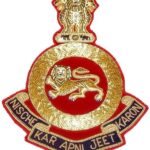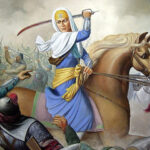The Sikh Regiment is a children’s army of the Indian army. The Sikh army is the highest armed force of the Indian Army and in 1979, the first army was the highly armed Commonwealth Army with 245 pre-independence awards and 82 post-independence awards, when it was transformed into the 4th Mechanized Infantry Regiment. The first military force was officially enlisted shortly before the Sikh occupation on August 1, 1846, by the British East India Company. Currently, the Sikh Regimental Center is located in Ramgarh Cantonment, Jharkhand. The center was previously located in Meerut, Uttar Pradesh.
The modern Sikh Regiment traces its roots directly to the 11th Sikh Regiment of the British Indian Army. When transferred to the Indian Armed Forces as its sister units, the initial value (in the case of the Sikh Regiment, 11) was removed and additional battles were raised, transferred, or disbanded to meet the needs of the army. With the humble start of the two-wheeled, today the fraternal group has grown to become an army of 19 regular soldiers and two heavily held battlefields. The 6th Army is taking over the reins of the Indian President’s palace.
History
After the First Anglo-Sikh War (1845-1846), Sikhs living in the area ruled by the Sikh Empire (Punjab province) began to be drafted into the British East India Company’s Bengal Army. Among the first Sikh units of the Bengal Army were the Regiment of Ferozepore (promoted in 1846) which later became the 14th King George’s Own Ferozepore Sikhs, and the Regiment of Ludhiana (also developed in 1846) and later the 15th Ludhiana Sikhs. [9] After the Second Anglo-Sikh War (1848-1849) many Punjabi began to be drafted into the Bengal Army, forming forces similar to the 1st Bengal Police Force, which later became 45 Sikhs in Rattray. Sikh units generally remained loyal to the British during the Indian Revolution of 1857, when many troops from the Bengal Army (mainly in Bengal, Bihar, and Awadh) rebelled against their British generals. After the uprising, troops from Bihar and Awadh were slowly recruited as they led the rebellion; the rental center then moved to Punjab and the Northwest Frontier, which resulted in many Sikhs being recruited from the Bengal Army. Numerous new Sikh festivals were proposed, such as 36 Sikhs and 35 Sikhs, both of whom were enlarged in 1887. 21 36 Sikh soldiers fought in the Battle of Saragarhi against 6,000-10,000 Pashtun tribes in 1897 during North-West campaigns. Frontier, in what some military historians consider to be one of the world’s largest museums. [10] In 1922 the Indian government transformed the British Indian Army into one army; this led to the formation of the 11th Sikh Regiment from 14th King George’s Own Ferozepore Sikhs, 15th Ludhiana Sikhs, 45th Rattray’s Sikhs, 36th Sikhs, 47th Sikhs, and 35th Sikhs. The 11th Sikh Regiment served during World War II and in the partition of India, this army was assigned to the newly formed Indian army, which became the Sikh Regiment.
As part of the British Indian Army, Sikh forces have fought in many wars around the world, such as the Second Opium War in China, the Second Anglo-Afghan War, numerous North-West Frontier, Western Front, Gallipoli, and Mesopotamian World War I campaigns, the Third British-Afghan War, and the North African, Italian and Burmese campaigns of World War II, won numerous awards for heroism and military recognition in the process.
During the Indo-Pakistani War of 1947-1948, the first Sikh Regiment force was the first air force to be deployed to Srinagar to help defend the Kashmir Valley against illegal Pakistani forces. [11] The Sikh Regiment also fought in the Sino-Indian War in 1962, the Indo-Pakistani wars of 1965 and 1971, and the Kargil War in 1999.
Hiring
The Sikh army is a “single-party” army. [12] The existing troops are recruited only from Jat Sikhs and their officers are not Jat Sikhs. [13] [14] They are trained at the Sikh Regimental Center, currently located in Ramgarh Cantonment, Jharkhand. The cry of an army battle, taken from Sikh inscriptions, by Jo Bole So Nihal, Sat Sri Akal. [A]
Units
1996 150-year postal stamp of the Sikh Regiment
The second army
- 3rd Battalion
- 4th Army
- 5th Army
- 6th Army
- 7th Army
- 8th Army
- 10th army
- 11th Army
- 13th Army
- 14th Army
- 16th Army
- 17th Army
- 18th Army
- 19th Army
- 20th Army
- 21st Army
- 22nd Army
- 23rd Army
- 24th Army
- Territorial Army (TA) Units-
- 124 Infantry Battalion (TA) (Sikh) located in New Delhi
- 152 Infantry Battalion (TA) (Sikh) located in Ludhiana, Punjab
- 157 Infantry Battalion (TA) (Sikh) (Home and Center) BD Bari, Jammu and Kashmir
Others:
The 1st Battalion is now the 4th Battalion, the Armed Forces Children’s Machine
The 9th Battalion was disbanded in 1984
The honor of war and honor of the theater
Battle honors
2006 postage stamp for 150 years Third Third Battalion, Sikh Army
Before Independence
- Lucknow 1857-58, 1 Sikh
- Arrah 1857, 3 Sikh
- Bihar 1857, 3 Sikh
- China 1860-62, 2 Sikh
- Ali Masjid 1878, 1 & 3 Sikh
- Ahmed Khel 1880, 2 Sikh
- Afghanistan 1878-79, 1 Sikh
- Afghanistan 1878-80, 2 & 3 Sikhs
- Kandahar 1880, 2 Sikh
- Suakin 1885, 2 Sikh
- Tofrek 1885, 2 Sikh
- Manipur 1891, 4 Sikh
- Chitral 1895, 1 & 2 Sikh
- Samana 1897, 4 Sikh
- Saragarhi / Gulistan 1897, 36 Sikh








